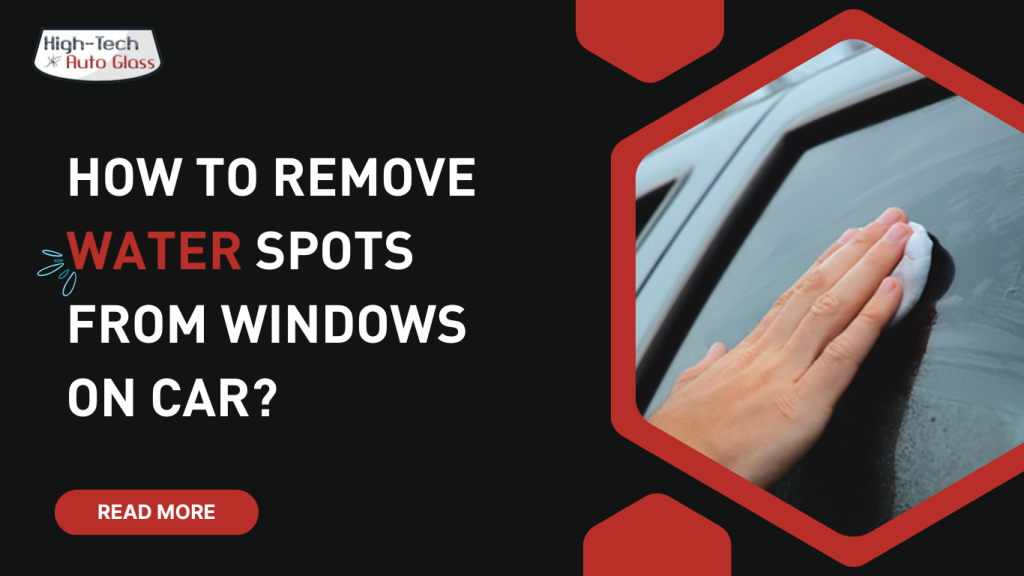How to Remove Water Spots From Windows On Car

Have you ever noticed those stubborn, white, chalky marks on your car windows after washing or a rainstorm? These are water spots, caused when water evaporates and leaves behind mineral deposits like calcium and magnesium. Hard water, rain mixed with pollutants, or even sprinkler systems can all leave these marks behind, making your car’s glass look dull and dirty.
Removing water spots isn’t just about keeping your car looking good—it’s essential for safety and maintenance. How to remove water spots from windows on car is important because clear windows improve visibility while driving, especially in bright sunlight or at night when these spots can scatter light and create glare. Plus, leaving water spots untreated can lead to permanent etching on the glass, making repairs costly down the line. A little care now can save you trouble later!
Understanding Water Spots
What Are Water Spots?
Water spots are those cloudy, white marks that often appear on car windows after water dries. They form when water, especially hard water, evaporates and leaves behind mineral deposits like calcium, magnesium, or other impurities. These minerals remain stuck to the surface, creating unsightly marks that can be tough to remove. Over time, if left untreated, these deposits can build up and even etch into the glass, causing permanent damage. UV rays can accelerate the buildup of water spots by drying mineral deposits quickly on the glass. Understanding whether car windows block UV rays helps you choose treatments to minimize these stains.
Water spots are a common issue on the exterior, but the interior of your windshield can also accumulate dirt and oils that impact clarity. Regular maintenance ensures a spotless view from both sides. Learn how to clean the inside of your windshield to complement your efforts in removing water spots.
Causes of Water Spots on Car Windows
Water spots can form due to several common reasons:
- Hard Water: This is the leading cause. When you wash your car with water containing high mineral content or your car is exposed to sprinklers using untreated hard water, water spots are likely to form.
- Rain: Rainwater often contains dissolved pollutants, dirt, and minerals. As it dries on your car windows, it can leave behind residue that turns into water spots. Properly sized windshield wipers ensure that rainwater is efficiently removed, reducing the chances of water spots forming. Learn what size windshield wipers you need to keep your windows clear and spot-free.
- Sprinkler Systems or Hose Sprays: If your car is parked near sprinklers or you use an unfiltered garden hose to rinse it, the water droplets left behind can evaporate and cause spots.
- Lack of Regular Cleaning: Dirt and debris on the car window can trap water, worsening the spotting problem when it dries.
By understanding what causes water spots, it becomes easier to prevent them and keep your car windows clear.
Water spots on car windows can worsen visibility, especially when paired with fog buildup. Keeping your windows clean and knowing how to defog car windows ensures a clear and safe driving experience in all conditions.
While water spots affect visibility, cracks on the windshield pose an even greater risk to safety. Addressing these issues promptly ensures a safer driving experience. Learn about the risks of driving with a cracked windshield and how to resolve them.
Effective 6 Methods to Remove Water Spots
Removing water spots from car windows doesn’t have to be a daunting task. With the right methods, you can restore your car’s glass to its spotless, crystal-clear state. Cold weather can make water spots harder to remove as they can freeze onto the windshield. Knowing how to defrost your windshield effectively ensures that water spots don’t turn into stubborn stains. Here are some practical techniques that work effectively to remove water stains from car windows:
1. Vinegar Solution
A simple and highly effective method involves using white vinegar:
- Mix equal parts of white vinegar and distilled water in a spray bottle.
- Spray the solution generously on the affected areas and let it sit for a few minutes.
- Wipe the spots with a clean microfiber cloth and rinse with water.
Why it works: The acetic acid in vinegar breaks down mineral deposits, making it easier to clean water spots off car windows without damaging the glass.
2. Lemon Juice
Fresh lemon juice is another natural remedy:
- Squeeze some fresh lemon juice onto a soft cloth or apply it directly to the spots.
- Rub gently, let it sit for a couple of minutes, and rinse with clean water.
Why it works: The citric acid in lemons dissolves hard water stains, making your car windows look clean and streak-free.
3. Baking Soda Paste
If you’re dealing with stubborn water spots, try this:
- Mix a small amount of water with baking soda to create a paste.
- Apply the paste to the water spots and gently scrub using a soft cloth.
- Rinse thoroughly and dry with a microfiber towel.
Why it works: Baking soda’s mild abrasiveness helps remove tough water spots without scratching the glass.
4. Clay Bar Treatment
A clay bar is a detailing tool designed to remove contaminants from car surfaces, including water spots:
- Spray a clay lubricant or soapy water onto the window.
- Gently rub the clay bar over the affected areas in a back-and-forth motion.
- Wipe off any residue with a clean microfiber cloth.
Why it works: The clay bar lifts mineral deposits and other impurities bonded to the glass surface, leaving it smooth and clean.
5. Toothpaste Scrub
Surprisingly, non-gel toothpaste can act as a mild abrasive:
- Apply a small amount of toothpaste to a damp cloth.
- Rub the spots gently in circular motions.
- Rinse thoroughly with water and wipe dry.
Why it works: The fine abrasives in toothpaste effectively scrub away light water spots without scratching the glass.
6. Rubbing Alcohol Solution
Rubbing alcohol is another useful household item:
- Mix one part rubbing alcohol with two parts distilled water.
- Apply the mixture to the spots using a clean cloth.
- Wipe off with a microfiber towel and rinse with clean water.
Why it works: Alcohol dissolves the minerals and dirt, making it easy to remove water stains from car windows.
Preventing Future Water Spots
Preventing water spots on your car windows is always easier than dealing with them after they form. By taking a few proactive steps, you can keep your windows looking clean and clear.
1. Regular Cleaning and Drying
Washing your car regularly and drying it immediately after can significantly reduce water spots. After rinsing, use a clean microfiber towel or a squeegee to dry the windows thoroughly. This prevents mineral deposits from settling as the water evaporates.
2. Use Distilled Water for Rinsing
When rinsing your car after a wash, consider using distilled water instead of tap water. Distilled water contains no minerals, meaning it won’t leave behind residues that turn into water spots.
3. Apply Glass Sealants or Ceramic Coatings
When rinsing your car after a wash, consider using distilled water instead of tap water. Distilled water contains no minerals, meaning it won’t leave behind residues that turn into water spots.
4. Park Smartly
Where you park your car plays a big role in avoiding water spots. Whenever possible, park away from sprinklers, under tree canopies, or other areas where water may splash or drip onto your car.
5. Use Water-Repellent Sprays
Water-repellent sprays, like Rain-X, can be applied to your car windows. These sprays ensure that water doesn’t stick to the glass and instead slides off quickly, leaving no time for spots to form.
Scratches on your car windows can trap water and mineral deposits, making water spots harder to remove. Repairing these scratches ensures a smooth surface for easier cleaning. Discover how to remove scratches from glass to simplify your maintenance routine.
6. Install a Water Softener for Home Washing
If you wash your car at home, consider investing in a water softener for your hose or a filtration system. This removes excess minerals from the water, minimizing the risk of water spots during washes.
Water spots may seem minor compared to chips caused by rocks, but both can impact visibility. Taking steps to avoid damage and keep your windshield clear is essential. Learn how to protect windshields from rocks to preserve your glass surface.
Conclusion
Keeping your car windows spotless isn’t just about aesthetics; it’s about safety and longevity. Regularly addressing water spots and taking steps to prevent them ensures you always have a clear view while driving. However, sometimes, hard water spots or etching can damage your windows beyond what DIY methods can fix. This is where professional help becomes essential.
If your car windows or windshield have suffered extensive damage from water spots or other issues, High-tech Autoglass is here to help. As experts in windshield replacement in Phoenix, AZ we not only restore your car’s glass to its pristine condition but also ensure it meets the highest safety standards. Our team uses top-quality materials and advanced techniques to deliver reliable, long-lasting results.
Choosing High-tech Autoglass means trusting a brand that values your safety and satisfaction. Whether it’s a minor repair or a full windshield replacement, we’re committed to providing the best service in Phoenix. Don’t let damaged windows compromise your visibility or your car’s value—let us help you drive safely and confidently.
Frequently Asked Questions
1. Can water spots on car windows cause permanent damage?
Yes, if left untreated, water spots can etch into the glass over time, leading to permanent marks that can’t be removed with standard cleaning methods.
2. Are water spots on car windows the same as scratches?
No, water spots are mineral deposits left behind when water evaporates, while scratches are physical damage to the glass surface. However, untreated water spots can sometimes lead to etching, which may resemble fine scratches. Preventing scratches on your windows ensures water doesn’t settle unevenly, reducing the likelihood of water spots. Learn how to prevent scratches on your car to maintain a flawless finish on your windows.
3. Is it safe to use household cleaners like ammonia or bleach on car windows?
Ammonia-based cleaners can be used on non-tinted windows, but they should be avoided on tinted glass as they can damage the film. Bleach is not recommended for car windows due to its harsh chemical nature, which can harm the glass and surrounding materials.
4. How do I clean water spots from tinted car windows?
For tinted windows, avoid abrasive or acidic solutions that might damage the tint. Use mild soapy water or a cleaner specifically designed for tinted glass. Tinted windows not only reduce glare but also help prevent the rapid drying of water, which can lead to spots. Explore the benefits of tinting car windows to enhance both aesthetics and functionality.
5. Can I use a razor blade to scrape off water spots?
While a razor blade can remove stubborn water spots, it must be used carefully and only on untreated glass surfaces. Using it improperly can scratch the glass or damage window tints.
6. Do ceramic coatings completely prevent water spots?
Ceramic coatings can reduce water spots significantly by creating a hydrophobic surface, but they may not prevent all spots entirely, especially in areas with very hard water.
7. How often should I clean my car windows to prevent water spots?
Ideally, you should clean your car windows every one to two weeks or whenever you notice dirt or water marks. Drying them immediately after washing or exposure to rain is key to preventing spots.
8. What’s the difference between hard water spots and acid rain spots?
Hard water spots are caused by mineral deposits from water, while acid rain spots result from rain mixed with environmental pollutants. Acid rain spots are often more corrosive and can cause quicker etching on the glass.
